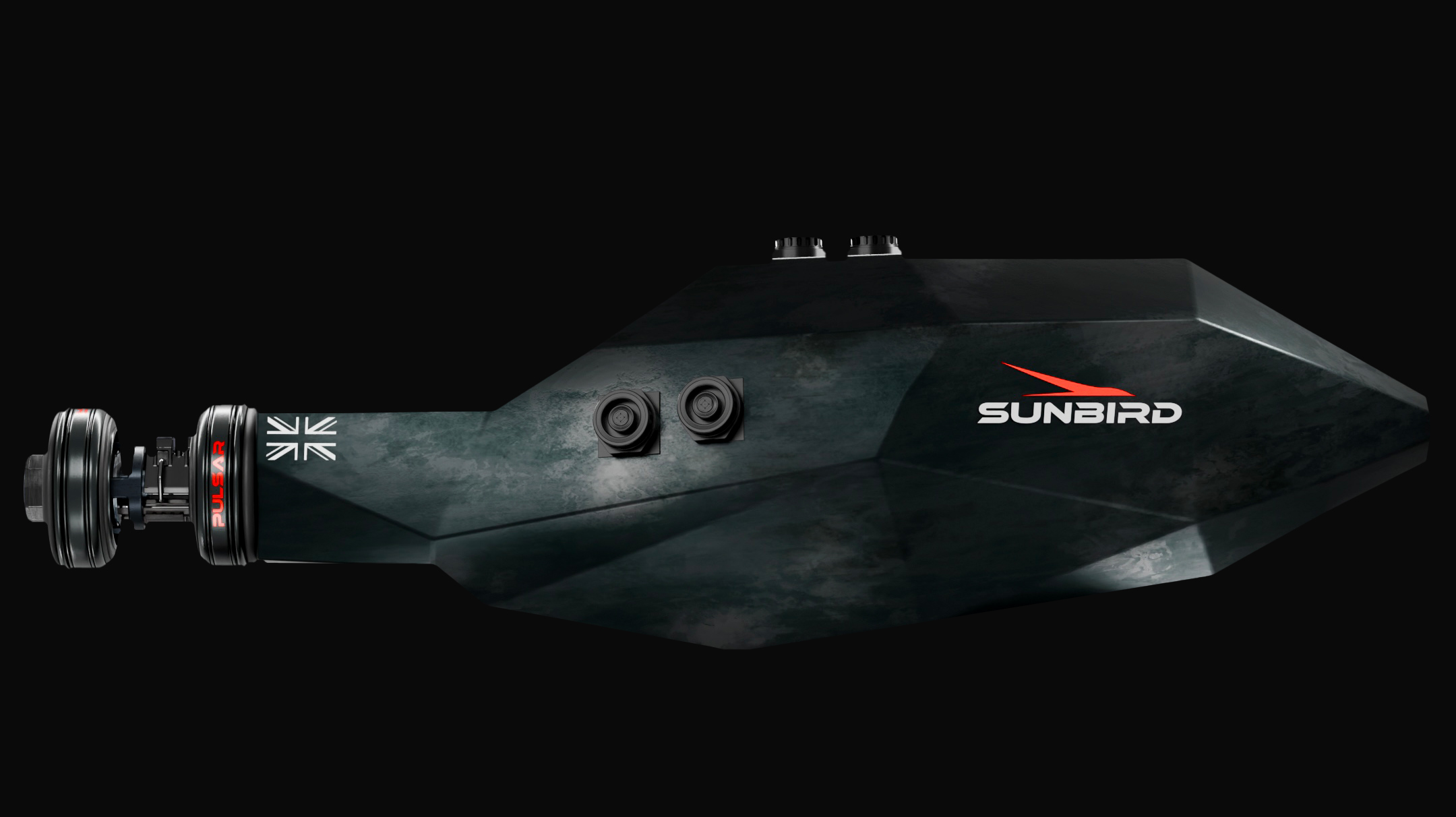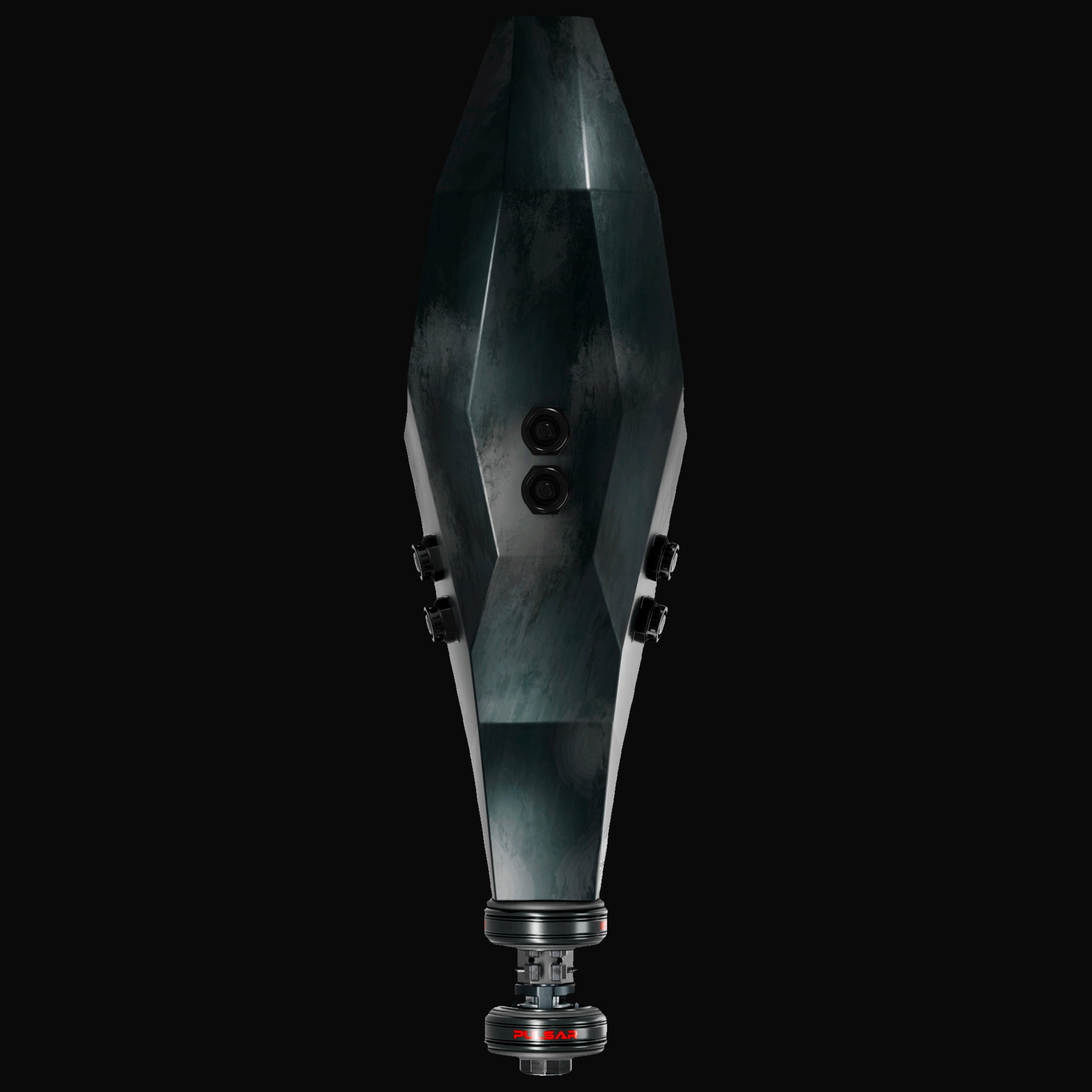Meet the Sunbird: a marvel of space propulsion innovation, powered by Pulsar Fusion’s state-of-the-art Dual Direct Fusion Drive (DDFD). With its remarkable high specific impulse (10,000–15,000 s) and 2 MW of power, the Sunbird redefines what’s possible in space travel.
Experience Sunbird
Get a glimpse into the future of propulsion with Pulsar Fusion’s Sunbird Fusion Drive. Dive into our interactive 3D experience to see the Sunbird in action and explore its revolutionary features.
Pulsar Fusion
Sunbird
Sunbird Migratory
Transfer Vehicle
Dual Direct Fusion Drive ‘(DDFD)’ is a compact design nuclear fusion engine which could provide both thrust and electrical power for spaceships. This technology opens unprecedented possibilities to explore the solar system in a limited amount of time and with a very high payload to propellant masses ratio.
2 MW of Power
Since DDFD provides power as well as propulsion in one integrated device, it would also provide as much as 2 MW of power to the payloads upon arrival. Designers think that this technology can radically expand the science capability of planetary missions.
Propel a Mass of 1,000 kg
Long-term source of acceleration with self-sustaining fuel supply. Modelling shows that this technology can potentially propel a spacecraft with a mass of about 1,000 kg (2,200 lb) to Pluto in 4 years.
In Orbit Demonstration
Static tests are to begin in 2025 followed by an In Orbit Demonstration (IOD) of the core technology components in 2027.
SUNBIRD’S DELTA V
Slashing Potential
Delta-V ((\Delta v)) for launching to LEO requires about 9.4 km/s. Using Pulsar Fusion’s DDFD, already stationed in orbit, allows spacecraft to dock at LEO. Skipping the massive delta-V cost of escaping Earth’s gravity well and traveling deeper into the solar system on their own.
LAUNCHING FROM EARTH
Missions with Sunbird
With Sunbird in Orbit: A spacecraft launches to LEO (~9.4 km/s), docks with a Sunbird, and then the Sunbird’s fusion propulsion handles the rest. 3–5 km/s to Mars or 6–10 km/s to Jupiter. The initial launch vehicle only needs enough delta-V to reach orbit, not the full interplanetary trip.
Sunbird’s Fusion Propulsion
3–5 km/s to Mars or 6–10 km/s to Jupiter. The initial launch vehicle only needs enough delta-V to reach orbit.
Designed for Thrust & Electric Power
- DESIGNED TO PRODUCE BOTH THRUST AND ELECTRIC POWER FOR INTERPLANETARY SPACECRAFT:
- Long-term source of acceleration
- Self-sustaining fuel supply
- Can potentially propel a spacecraft with a mass of about 1,000 kg (2,200 lb) to Pluto in 4 years
- 2 MW of power to the payloads
- Designers think that this technology can radically expand the science capability of planetary missions
Power Production
Pulsar Fusion’s 2 MW DDFD offers 2 MW of electrical power upon arrival, leveraging fusion’s dual-output capability. The revolutionary steady state fusion propulsion concept is based on a set of compact, linear fusion reactors. It will provide power of the order of units of MW, providing both thrust of the order of 10−101N with specific impulses between 10,000 – 15,000 seconds and auxiliary power to the space system.
Timeline
Pulsar Fusion is presently committed to the construction of its initial Sunbird prototype. After completing a State of the Art (SoA) assessment on heating technology in 2021, further analysis was carried out by a panel of experts to finally make an informed decision on an initial design point for the system.
Pulsar has now proceeded to phase 3, the manufacture of the initial test unit. Static tests are to begin in 2025 followed by an In Orbit Demonstration (IOD) of the core technology components in 2027.
Sunbird’s Delta V
Slashing Potential
Delta-V (( \Delta v )) is the change in velocity needed for a spacecraft to complete its mission, and launching from Earth’s surface to low Earth orbit (LEO) is one of the most energy-intensive steps. It typically requires about 9.4 km/s of delta-V to reach LEO (accounting for gravity and atmospheric drag). If the Sunbirds, powered by Pulsar Fusion’s Dual Direct Fusion Drive (DDFD), are designed to already be stationed in orbit. Spacecraft only need to reach LEO (or a similar orbit) to dock with them, skipping the massive delta-V cost of escaping Earth’s gravity well and traveling deeper into the solar system on their own.
- SLASHING POTENTIAL
- Standard Mission: A craft launching from Earth to Mars needs ~11.3 km/s (9.4 km/s to LEO + ~1.9 km/s for trans-Mars injection). For outer solar system missions (e.g., Jupiter), it’s even higher (~14.4 km/s total).
- With Sunbird in Orbit: A spacecraft launches to LEO (~9.4 km/s), docks with a Sunbird, and then the Sunbird’s fusion propulsion handles the rest. 3–5 km/s to Mars or 6–10 km/s to Jupiter. The initial launch vehicle only needs enough delta-V to reach orbit, not the full interplanetary trip.
- The Sunbird’s high specific impulse (10,000–15,000 s) and 2 MW power mean it can efficiently provide the additional delta-V with minimal propellant, thanks to its fusion-driven exhaust velocity (~98,100–147,150 m/s). This could cut the total delta-V burden on the launch vehicle by 20–50%, depending on the destination, and massively reduce fuel mass—making missions cheaper, lighter, and more flexible.
Five Commercial Fusion Propulsion Missions
Five commercial fusion propulsion missions that the Sunbird Migratory Transfer Vehicle, powered by the Dual Direct Fusion Drive (DDFD), could be uniquely positioned to achieve.
These missions leverage the Sunbird’s in-orbit deployment, its 2 MW fusion power output, and the significant delta-V reductions from docking in low Earth orbit (LEO). Additionally, requiring the use of Pulsar’s MARSRANGER 10 kW Hall Effect Thrusters (HET) for station-keeping and orbital transfers, enhancing the Sunbird’s versatility.

Rapid Cargo Delivery to Mars
- [CARGO > MARS]
- Mission Description: Transporting 1000–2000 kg of commercial cargo (e.g., habitats, rovers, or supplies) to Mars orbit in under 6 months, docking with a pre-launched spacecraft in LEO.
- Power Generation Advantage: The DDFD’s 2 MW output (with ~1 MW auxiliary power) supports high-bandwidth data relays and powers onboard systems (e.g., refrigeration for perishables or laser comms), eliminating solar panel reliance in Mars’ weaker sunlight (588 W/m² vs. 1361 W/m² at Earth).
- Delta-V Reduction: Launch to LEO requires ~9.4 km/s, but the Sunbird handles the ~3.6 km/s trans-Mars injection (TMI) and ~1.5 km/s Mars orbit insertion (MOI), cutting total mission delta-V from ~14.5 km/s to ~9.4 km/s—a 35% reduction. This slashes launch vehicle propellant by ~50%
- Unique Advantage: Faster transit (150 days vs. 210+ with chemical propulsion) and reduced launch costs enable frequent, cost-effective commercial Mars logistics.
Outer Planet Science Probe Deployment (Jupiter/Saturn)
- [0UTER_SPACE]
- Mission Description: The Sunbird fusion engines ferry a 1000 kg science probe to Jupiter (5.2 AU) or Saturn (9.5 AU) in 2–4 years, deploying it into orbit for detailed study (e.g., Europa’s subsurface ocean or Titan’s atmosphere).
- Power Generation Advantage: The 2 MW DDFD provides ~1 MW to the probe upon arrival, powering high-energy instruments (e.g., radar, plasma detectors) and beaming data back at gigabit rates—unfeasible with solar power at 5–10% Earth’s intensity (50–15 W/m²).
- Delta-V Reduction: From Earth, Jupiter requires ~14.4 km/s (9.4 km/s to LEO + 5 km/s transfer) and Saturn ~15.7 km/s. Docking with Sunbird in LEO drops this to 9.4 km/s for launch, with Sunbird covering ~6.1 km/s (Jupiter) or ~7.4 km/s (Saturn)—a 30–40% delta-V cut. Propellant mass drops by ~60% for the launch vehicle.
- Unique Advantage: High power at destination and reduced launch mass enable larger, more capable probes to outer planets, slashing transit time vs. chemical (7–8 years to Saturn).
Lunar Orbital Supply Hub
- [LEO > MOON]
- Mission Description: The Sunbird serves as a reusable LEO-to-Moon transfer vehicle, delivering 1500 kg of supplies (e.g., fuel, water, or equipment) to lunar orbit for commercial stations or landers.
- Power Generation Advantage: The ~1 MW auxiliary power supports in-orbit processing (e.g., electrolysis for fuel) and powers docking systems or laser-based debris tracking, critical in the crowded lunar environment.
- Delta-V Reduction: A full Earth-to-lunar orbit trip needs ~15.1 km/s (9.4 km/s to LEO + 5.7 km/s). With Sunbird in LEO, the launch delta-V drops to 9.4 km/s, and Sunbird covers the ~4.1 km/s LEO-to-lunar orbit leg (using Oberth effect)—a 38% reduction. Launch propellant mass decreases by ~55%.
- Unique Advantage: Reusability and high power reduce costs for sustained lunar commerce, supporting a cislunar economy with minimal launch overhead.
Asteroid Mining Transport
- [MINING_EQUIPMENT > NEA]
- Mission Description: The Sunbird transports mining equipment (1000 kg) to a near-Earth asteroid (NEA) and returns up to 500 kg of extracted resources (e.g., water, metals) to LEO.
- Power Generation Advantage: The 2 MW fusion rockets power mining ops (e.g., drilling, ore processing) with ~1 MW, far exceeding solar capabilities at 1–2 AU, and supports high-rate data transfer for remote operation.
- Delta-V Reduction: NEA missions vary (e.g., ~12–14 km/s total from Earth). Docking with Sunbird in LEO cuts launch delta-V to 9.4 km/s, with Sunbird handling ~3–5 km/s to the asteroid and back (often aided by aerobraking on return)—a 25–40% reduction. Launch mass savings exceed 50%.
- EIGHT MARSRANGER 10kW HET ‘s adjust Sunbird’s trajectory for NEA intercept and maintains position during mining to avoid DDFD fuel use for low-thrust manoeuvres.
- Unique Advantage: High power and delta-V efficiency enable heavier equipment and faster round-trips (1–2 years vs. 3+), boosting asteroid mining profitability.
Deep Space Telescope Ferry
- [TELESCOPE > 0RBIT]
- Mission Description: The Sunbird delivers a 1000 kg next-gen telescope to a distant orbit (e.g., 100 AU or Sun-Earth L2) for unparalleled astronomical observation.
- Power Generation Advantage: The ~1 MW auxiliary power drives advanced cooling systems (e.g., cryogenics for IR detectors) and high-bandwidth comms, enabling real-time data streaming from vast distances where solar power is negligible (<14 W/m² at 100 AU).
- Delta-V Reduction: L2 requires ~12.7 km/s from Earth (9.4 km/s to LEO + 3.3 km/s); 100 AU needs ~20 km/s+. Sunbird in LEO reduces launch to 9.4 km/s, covering ~3.3 km/s (L2) or ~10–15 km/s (100 AU)—a 26–50% delta-V cut. Launch propellant drops by 40–60%.
- FOUR MARSRANGER 10kW HET ‘s ensure precise LEO station-keeping pre-mission and performs final orbit insertion at L2 or heliocentric drift for long-term stability without DDFD fuel burn.
- Unique Advantage: High power and reduced launch costs make ambitious observatories feasible, placing them far beyond current limits (e.g., JWST at L2) with shorter transit times.

